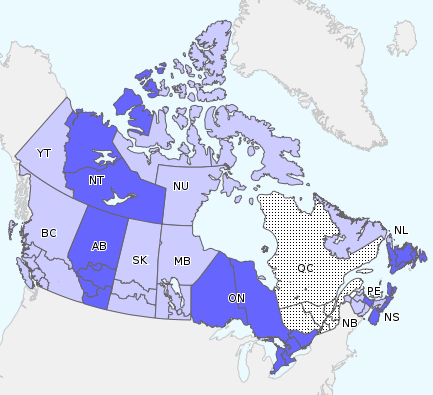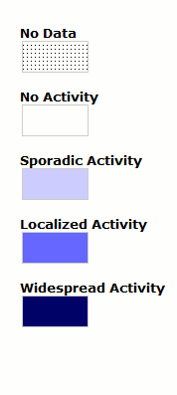FluWatch report: March 13 to March 19, 2016 (week 11)
Overall Summary
- Influenza activity remains near its peak, but has begun to decrease across Canada.
- The proportion of influenza laboratory confirmed cases has decreased, suggesting that the peak of the season may have occurred.
- Nearly all regions in Canada are reporting sporadic or localized influenza activity.
- In week 11, 23 outbreaks were reported and the majority of outbreaks were in long-term care facilities.
- Adults greater than 65 years of age accounted for the majority of hospitalizations in week 11 and now account for the largest proportion of hospitalizations to date this season.
- Hospitalizations, ICU admissions and deaths among the pediatric population are above typical peak season levels.
- For more information on the flu, see our Flu(influenza) web page.
Are you a primary health care practitioner (General Practitioner, Nurse Practitioner or Registered Nurse) interested in becoming a FluWatch sentinel for the 2015-16 influenza season? Contact us at FluWatch@phac-aspc.gc.ca
On this page
- Influenza/ILI Activity (geographic spread)
- Laboratory Confirmed Influenza Detections
- Influenza-like Illness Consultation Rate
- Pharmacy Surveillance
- Influenza Outbreak Surveillance
- Sentinel Pediatric Hospital Influenza Surveillance
- Provincial/Territorial Influenza Hospitalizations and Deaths
- Influenza Strain Characterizations
- Antiviral Resistance
- International Influenza Reports
- FluWatch definitions for the 2015-2016 season

Download the alternative format
(PDF format, 876 KB, 9 pages)
Related Topics
Influenza/Influenza-like Illness Activity (geographic spread)
In week 11, influenza activity was present in all but one region in Canada. A total of 22 regions reported localized activity levels with the majority in the eastern regions of Canada. Sporadic influenza/ILI activity was reported in 27 regions across Canada.
Figure 1. Map of overall influenza/ILI activity level by province and territory, Canada, week 11
Note: Influenza/ILI activity levels, as represented on this map, are assigned and reported by Provincial and Territorial Ministries of Health, based on laboratory confirmations, sentinel ILI rates and reported outbreaks. Please refer to detailed definitions at the end of the report. Maps from previous weeks, including any retrospective updates, are available in the mapping feature found in the Weekly Influenza Reports.
Figure 1 - Text Description
In week 11, influenza activity was present in all but one region in Canada. A total of 20 regions reported localized activity levels with the majority in the eastern regions of Canada. Sporadic influenza/ILI activity was reported in 24 regions across Canada.
Laboratory Confirmed Influenza Detections
For the first time since week 49 of 2015, the percent positive for influenza decreased from the previous week [from 36% in week 10 to 31% in week 11 (Figure 2)]. This decrease from the previous week suggests that the influenza season peaked in week 10. Compared to the previous five seasons, the percent positive (31%) reported in week 11 was above the five year average for that week and exceeded the expected levels (range 11.9%-19.3%). With the late start to the 2015-16 influenza season, these above normal levels are not unexpected and are typical of peak season levels.
Figure 2. Number of positive influenza tests and percentage of tests positive, by type, subtype and report week, Canada, 2015-16
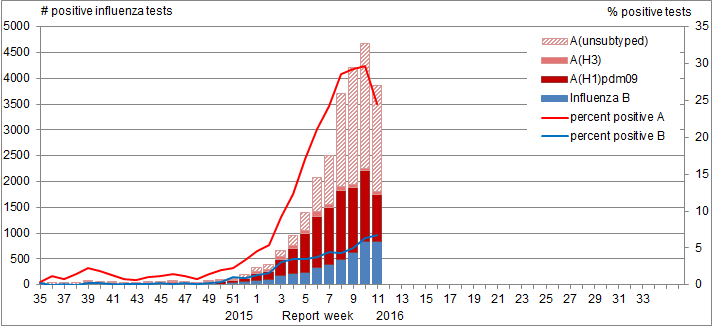
Figure 2 - Text Description
For the first time since week 49 of 2015, the percent positive for influenza decreased from the previous week [from 36% in week 10 to 31% in week 11].
In week 11, there were 3,596 positive influenza tests reported. All regions across Canada reported a decrease in the percent of positive influenza tests compared to the previous week. To date, 83% of influenza detections have been influenza A and among those subtyped, the vast majority have been influenza A(H1N1) [91% (8946/9863].
Figure 3. Cumulative numbers of positive influenza specimens by type/subtype and province, Canada, 2015-16
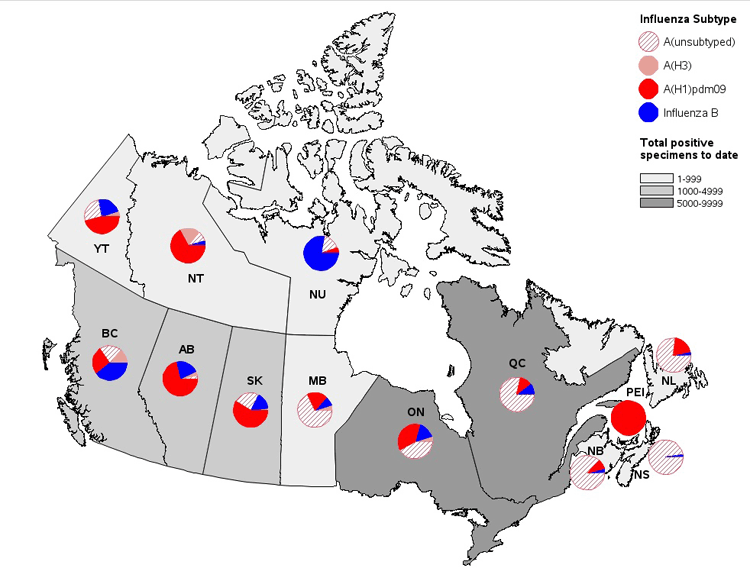
Note: Specimens from NT, YT, and NU are sent to reference laboratories in other provinces. Cumulative data includes updates to previous weeks.
Figure 3 - Text Description
| Reporting provincesTable Figure 3 - Footnote 1 |
Weekly (March 13 to March 19, 2016) | Cumulative (August 30, 2015 to March 19, 2016) | |||||||||
|---|---|---|---|---|---|---|---|---|---|---|---|
| Influenza A | B | Influenza A | B | A & B Total |
|||||||
| A Total |
A (H1)pdm09 |
A (H3) |
A Table Figure 3 - Footnote UnS | B Total |
A Total |
A (H1)pdm09 |
A (H3) |
ATable Figure 3 - Footnote UnS | B Total |
||
| BC | 109 | 58 | <5 | Table Figure 3 - Footnote x | 46 | 1442 | 653 | 329 | 460 | 975 | 2353 |
| AB | 212 | 152 | <5 | Table Figure 3 - Footnote x | 152 | 3476 | 3172 | 161 | 143 | 970 | 4446 |
| SK | 106 | 91 | 6 | 9 | 34 | 1750 | 1214 | 36 | 500 | 321 | 2071 |
| MB | 108 | 19 | 0 | 89 | 27 | 714 | 147 | 35 | 532 | 68 | 782 |
| ON | 930 | 307 | 26 | 597 | 270 | 5921 | 2653 | 320 | 2948 | 1156 | 7077 |
| QC | 1,112 | 135 | <5 | Table Figure 3 - Footnote x | 223 | 6527 | 850 | <5 | Table Figure 3 - Footnote x | 747 | 7274 |
| NB | 129 | 11 | <5 | Table Figure 3 - Footnote x | 6 | 423 | 38 | <5 | Table Figure 3 - Footnote x | 15 | 438 |
| NS | 34 | 0 | 0 | 34 | 0 | 169 | 0 | <5 | Table Figure 3 - Footnote x | <5 | 172 |
| PE | <5 | <5 | 0 | Table Figure 3 - Footnote x | 0 | 48 | 48 | 0 | 0 | Table Figure 3 - Footnote x | 48 |
| NL | 67 | 8 | 0 | 59 | <5 | 285 | 58 | <5 | Table Figure 3 - Footnote x | 9 | 294 |
| YT | 7 | <5 | 0 | <5 | 0 | 59 | 35 | <5 | Table Figure 3 - Footnote x | 17 | 76 |
| NT | 17 | 10 | <5 | Table Figure 3 - Footnote x | <5 | 110 | 77 | 22 | 11 | 5 | 115 |
| NU | Table Figure 3 - Footnote x | 0 | Table Figure 3 - Footnote x | <5 | 0 | <5 | <5 | 0 | <5 | 0 | 18 |
| Canada | 2836 | 799 | 41 | 1996 | 760 | 20928 | 8946 | 917 | 11065 | 4300 | 25228 |
| Percentage Table Figure 3 - Footnote 2 | 79% | 28% | 1% | 70% | 21% | 83% | 43% | 4% | 53% | 17% | 100% |
To date this season, detailed information on age and type/subtype has been received for 21,888 cases. Adults aged 20-44 years accounted for the greatest proportion of influenza cases, followed closely by adults aged 45-64 (Table 1). Adults aged 20-44 and 45-64 years accounted for 55% of reported influenza A(H1N1) cases. Children 5-19 years and adults 20-44 years accounted for 56% of all influenza B cases reported.
| Age groups (years) | Weekly (March 13 to March 19, 2016) | Cumulative (August 30, 2015 to March 19, 2016) | ||||||||||
|---|---|---|---|---|---|---|---|---|---|---|---|---|
| Influenza A | B | Influenza A | B | Influenza A and B | ||||||||
| A Total | A(H1) pdm09 | A(H3) | A UnSTable 1 - Footnote 3 | Total | A Total | A(H1) pdm09 | A(H3) | A UnSTable 1 - Footnote 3 | Total | # | % | |
| <5 | 366 | 62 | <5 | Table 1 - Footnote x | 69 | 3570 | 1354 | 53 | 2163 | 464 | 4035 | 18% |
| 5-19 | 244 | 29 | <5 | Table 1 - Footnote x | 122 | 2144 | 798 | 82 | 1264 | 910 | 3054 | 14% |
| 20-44 | 368 | 73 | <5 | Table 1 - Footnote x | 73 | 4756 | 2042 | 124 | 2590 | 816 | 5572 | 25% |
| 45-64 | 503 | 100 | <5 | Table 1 - Footnote x | 33 | 4833 | 1860 | 161 | 2812 | 378 | 5211 | 24% |
| 65+ | 444 | 77 | <5 | Table 1 - Footnote x | 92 | 3500 | 1078 | 351 | 2071 | 516 | 4016 | 18% |
| Total | 1925 | 341 | 16 | 1568 | 389 | 18803 | 7132 | 771 | 10900 | 3084 | 21888 | 100% |
| PercentageTable 1 - Footnote 2 | 83% | 18% | 1% | 81% | 17% | 86% | 38% | 4% | 58% | 14% | ||
For data on other respiratory virus detections see the Respiratory Virus Detections in Canada Report on the Public Health Agency of Canada website.
Influenza-like Illness Consultation Rate
The national ILI consultation rate decreased from the previous week from 75.6 per 1,000 patient visits in week 10, to 58.4 per 1,000 patient visits in week 11.The highest ILI consultation rate was found in the 0-4 years of age group (68.2 per 1,000) and the lowest was found in the 5-19 years age group (25.3 per 1,000) (Figure 4).
Figure 4. Influenza-like-illness (ILI) consultation rates by age group and week, Canada, 2015-16
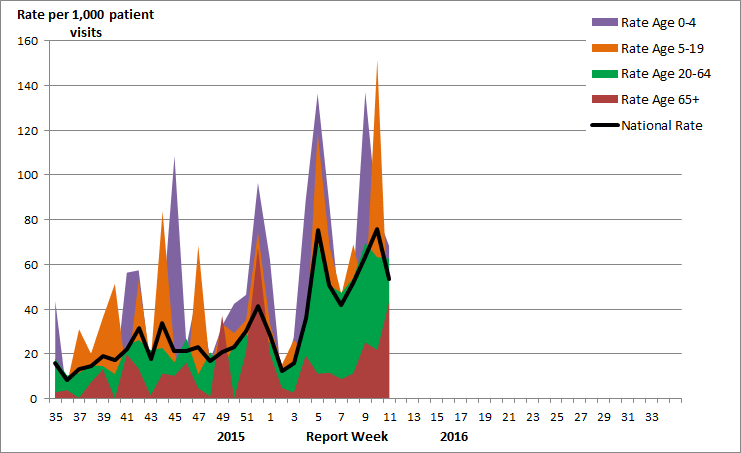
Delays in the reporting of data may cause data to change retrospectively. In BC, AB, and SK, data are compiled by a provincial sentinel surveillance program for reporting to FluWatch. Not all sentinel physicians report every week.
Figure 4 - Text Description
Influenza-like illness consultation rate by age-group in week 11 for the 2015-16 season:
Age 0-4: 68.3; Age 5-19: 25.3; Age 20-64: 62.8; Age 65+: 43.2
Pharmacy Surveillance
During week 11, the proportion of prescriptions for antivirals decreased to 123.5 antiviral prescriptions per 100,000 total prescriptions, which is higher than the five year historical average for week 11. The highest proportion of prescriptions for antivirals remains highest among children. In week 11, the proportion reported among children was 257.1 per 100,000 total prescriptions.
Figure 5. Proportion of prescription sales for influenza antivirals by age group and week, Canada, 2015-16
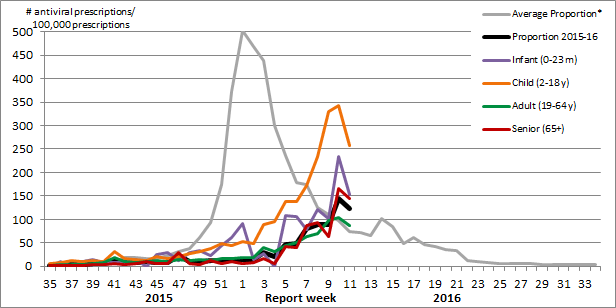
Note: Pharmacy sales data are provided to the Public Health Agency of Canada by Rx Canada Inc. and sourced from major retail drug chains representing over 3,000 stores nationwide (excluding Nunavut) in 85% of Health Regions. Data provided include the number of new antiviral prescriptions (for Tamiflu[oseltamivir] and Relenza [zanamivir]) and the total number of new prescriptions dispensed by Province/Territory and age group.
* The average weekly proportion includes data from April 2011 to March 2015.
Figure 5 - Text Description
Proportion of antiviral prescriptions per 100,000 total prescriptions
Average National Rate (Yrs 10-11 to 14-15): 73.3.; Rate wk 11: 123.5
Proportion of antiviral prescriptions by age-group in week 11 for the 2015-16 season:
Infant: 152.4; child: 257.1; adult: 87.7; senior: 144.8
Influenza Outbreak Surveillance
In week 11, 23 new laboratory confirmed influenza outbreaks were reported: 17 in long-term care facilities (LTCF), two in hospitals and 4 in institutions or community settings. Of the outbreaks with known strains or subtypes, three outbreaks were due to influenza B, one outbreak was due to influenza A(H1N1) and four were due to influenza A(Uns). Additionally, one ILI outbreak was reported in a school.
To date this season, 298 outbreaks have been reported. At week 11 in the 2014-15 season, 1,552 outbreaks were reported and in the 2013-14 season,157 outbreaks were reported.
Figure 6. Overall number of new laboratory-confirmed influenza outbreaksFigure 5 - Footnote 1 by report week, Canada, 2015-2016

Figure 6 - Text Description
| Report week | Hospitals | Long Term Care Facilities | Other |
|---|---|---|---|
| 35 | 0 | 0 | 0 |
| 36 | 0 | 0 | 0 |
| 37 | 1 | 1 | 0 |
| 38 | 0 | 0 | 0 |
| 39 | 0 | 2 | 0 |
| 40 | 0 | 2 | 1 |
| 41 | 0 | 0 | 0 |
| 42 | 0 | 0 | 0 |
| 43 | 0 | 1 | 0 |
| 44 | 1 | 3 | 1 |
| 45 | 1 | 1 | 0 |
| 46 | 0 | 0 | 0 |
| 47 | 0 | 0 | 0 |
| 48 | 0 | 1 | 0 |
| 49 | 0 | 1 | 0 |
| 50 | 0 | 2 | 0 |
| 51 | 1 | 1 | 0 |
| 52 | 1 | 0 | 2 |
| 1 | 0 | 2 | 1 |
| 2 | 0 | 2 | 0 |
| 3 | 1 | 4 | 1 |
| 4 | 4 | 6 | 3 |
| 5 | 8 | 6 | 3 |
| 6 | 8 | 10 | 3 |
| 7 | 2 | 17 | 8 |
| 8 | 6 | 27 | 7 |
| 9 | 13 | 24 | 8 |
| 10 | 9 | 23 | 14 |
| 11 | 2 | 17 | 4 |
Sentinel Pediatric Hospital Influenza Surveillance
Paediatric Influenza Hospitalizations and Deaths
In week 11, 93 hospitalizations were reported by the the Immunization Monitoring Program Active (IMPACT) network, a decrease from the previous two weeks (Figure 7). The largest proportion of hospitalizations were in children aged 6-23 months and children 2-4 years months, each accounting for 27% of the hospitalizations. The majority of hospitalizations were due to influenza A (68%).
To date this season, 896 laboratory-confirmed influenza-associated pediatric (≤16 years of age) hospitalizations have been reported by the IMPACT network: 711 hospitalized cases were due to influenza A and 185 cases were due to influenza B. The greatest proportion of hosptalization cases were in children aged 6-23 months and children 2-4 years, each accounting for 28% of hospitalizations. To date, 151 intensive care unit (ICU) admissions have been reported. Children aged 2 to 4 years accounted for 27% of ICU admissions. A total of 71 ICU cases (47%) reported to have at least one underlying condition or comorbidity. Seven influenza-associated deaths have been reported.
| Age Groups | Cumulative (30 Aug. 2015 to 19 March 2016) | |||||
|---|---|---|---|---|---|---|
| Influenza A | Influenza B | Influenza A and B (#(%)) | ||||
| A Total | A(H1) pdm09 | A(H3) | A (UnS) | B Total | ||
| 0-5m | 95 | 29 | <5 | Table 2 - Footnote x | 13 | 108 (12%) |
| 6-23m | 211 | 63 | 7 | 141 | 43 | 254 (28%) |
| 2-4y | 208 | 71 | <5 | Table 2 - Footnote x | 42 | 250 (28%) |
| 5-9y | 146 | 44 | <5 | Table 2 - Footnote x | 60 | 206 (23%) |
| 10-16y | 51 | 17 | <5 | Table 2 - Footnote x | 27 | 78 (9%) |
| Total | 711 | 224 | 19 | 468 | 185 | 896 (100%) |
Figure 7. Number of cases of influenza reported by sentinel hospital networks, by week, Canada, 2015-16, paediatric and adult hospitalizations (≤16 years of age, IMPACT; ≥16 years of age, CIRN-SOS)
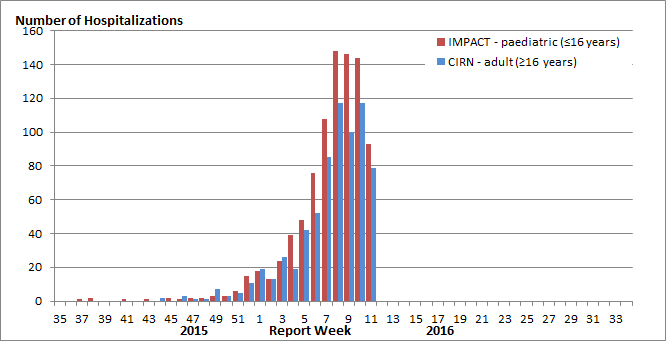
Not included in Table 2 and Figure 7 are two IMPACT cases that were due to co-infections of influenza A and B.
Figure 7 - Text Description
| Report week | IMPACT | CIRN-SOS |
|---|---|---|
| 35 | 0 | 0 |
| 36 | 0 | 0 |
| 37 | 1 | 0 |
| 38 | 2 | 0 |
| 39 | 0 | 0 |
| 40 | 0 | 0 |
| 41 | 1 | 0 |
| 42 | 0 | 0 |
| 43 | 1 | 0 |
| 44 | 0 | 2 |
| 45 | 2 | 0 |
| 46 | 1 | 3 |
| 47 | 2 | 1 |
| 48 | 2 | 1 |
| 49 | 3 | 7 |
| 50 | 3 | 3 |
| 51 | 6 | 5 |
| 52 | 15 | 11 |
| 1 | 18 | 19 |
| 2 | 13 | 13 |
| 3 | 24 | 26 |
| 4 | 39 | 19 |
| 5 | 48 | 42 |
| 6 | 76 | 52 |
| 7 | 108 | 85 |
| 8 | 148 | 117 |
| 9 | 146 | 100 |
| 10 | 144 | 117 |
| 11 | 93 | 79 |
Adult Influenza Hospitalizations and Deaths
In week 11, 80 hospitalizations were reported by the Canadian Immunization Research Network Serious Outcome Surveillance (CIRN-SOS) (Figure 7). The largest proportion of hospitalizations were in adults 65+ years of age (51%) and due to influenza A (78%).
To date this season, 702 laboratory-confirmed influenza-associated adult (≥16 years of age) hospitalizations have been reported by CIRN-SOS (Table 3). The majority of hospitalized cases were due to influenza A (87%) and the largest reported proportion were among adults ≥65 years of age (48%). Ninety-three intensive care unit (ICU) admissions have been reported and among those, 83 (89%) were due to influenza A. A total of 51 ICU cases (55%) reported to have at least one underlying condition or comorbidity. Twenty-four deaths have been reported this season.
| Age groups (years) | Cumulative (1 Nov. 2015 to 19 March 2016) | |||||
|---|---|---|---|---|---|---|
| Influenza A | B | Influenza A and B | ||||
| A Total | A(H1) pdm09 | A(H3) | A(UnS) | Total | # (%) | |
| 16-20 | <5 | <5 | 0 | <5 | 0 | <5 (Table 3 - Footnote x%) |
| 20-44 | 94 | 32 | <5 | Table 3 - Footnote x | 20 | 114 (16%) |
| 45-64 | 219 | 62 | <5 | Table 3 - Footnote x | 22 | 241 (34%) |
| 65+ | 286 | 62 | 21 | 203 | 51 | 337 (48%) |
| Unknown | Table 3 - Footnote x | Table 3 - Footnote x | Table 3 - Footnote x | <5 | 0 | Table 3 - Footnote x%) |
| Total | 609 | 162 | 26 | 421 | 93 | 702 |
| % | 87% | 27% | 4% | 69% | 13% | 100% |
Figure 8. Percentage of hospitalizations, ICU admissions and deaths with influenza reported by age-group (≥16 year of age), Canada 2015-16

Note: The number of hospitalizations reported through CIRN-SOS and IMPACT represents a subset of all influenza-associated adult and paediatric hospitalizations in Canada. Delays in the reporting of data may cause data to change retrospectively.
x - Suppressed to prevent residual disclosure.
Figure 8 - Text Description
| Age-group (years) | Hospitalizations (n=696) | ICU admissions (n=93) | Deaths (n=24) |
|---|---|---|---|
| 16-20 | Table Figure 8 - Footnote x | Table Figure 8 - Footnote x | Table Figure 8 - Footnote x |
| 20-44 | Table Figure 8 - Footnote x | Table Figure 8 - Footnote x | Table Figure 8 - Footnote x |
| 45-64 | 34.6% | 40.9% | 25.0% |
| 65+ | 48.4% | 34.4% | 66.7% |
Provincial/Territorial Influenza Hospitalizations and Deaths
Since the start of the 2015-16 season, 3,033 laboratory-confirmed influenza-associated hospitalizations have been reported. A total of 2,649 hospitalizations (87%) were due to influenza A and 384 (13%) were due to influenza B. Among cases for which the subtype of influenza A was reported, 93% (1327/1433) were influenza A(H1N1). The largest proportion (29%) of hospitalized cases were ≥65 years of age, followed closely by adults 45-64 years of age (27%). Three hundred and thirty eight ICU admissions have been reported of which 216 (64%) were due to influenza A(H1N1) and 149 (44%) were in the 45-64 age group. A total of 111 deaths have been reported; all but six were due to influenza A. Adults ≥65 years of age each represented 49% of reported deaths.
Figure 9. Percentage of hospitalizations, ICU admissions and deaths with influenza reported by age-group, Canada 2015-16

x - Suppressed to prevent residual disclosure.
Figure 9 - Text Description
| Age-group (years) | Hospitalizations (n=3033) | ICU admissions (n=338) | Deaths (n=110) |
|---|---|---|---|
| 0-4 | 20.6% | 11.5% | Table Figure 9 - Footnote x% |
| 5-19 | 9.2% | 6.5% | Table Figure 9 - Footnote x% |
| 20-44 | 14.3% | 18.3% | 7.3% |
| 45-64 | 26.6% | 44.1% | 37.3% |
| 65+ | 29.2% | 19.5% | 49.1% |
See additional data on Reported Influenza Hospitalizations and Deaths in Canada: 2011-12 to 2015-16 on the Public Health Agency of Canada website.
Influenza Strain Characterizations
During the 2015-16 influenza season, the National Microbiology Laboratory (NML) has characterized 994 influenza viruses [140 A(H3N2), 611 A(H1N1) and 243 influenza B]. Due to the early production of this report, data are only available up to week 10.
Influenza A (H3N2): When tested by hemagglutination inhibition (HI) assays, 29 H3N2 virus were antigenically characterized as A/Switzerland/9715293/2013-like using antiserum raised against cell-propagated A/Switzerland/9715293/2013.
Sequence analysis was done on 111 H3N2 viruses. All viruses belonged to a genetic group for which most viruses were antigenically related to A/Switzerland/9715293/2013. A/Switzerland/9715293/2013 is the A(H3N2) component of the 2015-16 Northern Hemisphere's vaccine.
Influenza A (H1N1): A total of 611 H1N1 viruses characterized were antigenically similar to A/California/7/2009, the A(H1N1) component of the 2015-16 influenza vaccine.
Influenza B: A total of 77 influenza B viruses characterized were antigenically similar to the vaccine strain B/Phuket/3073/2013. A total of 166 influenza B viruses were characterized as B/Brisbane/60/2008-like, one of the influenza B components of the 2015-16 Northern Hemisphere quadrivalent influenza vaccine.
The recommended components for the 2015-2016 northern hemisphere trivalent influenza vaccine include: an A/California/7/2009(H1N1)pdm09-like virus, an A/Switzerland/9715293/2013(H3N2)-like virus, and a B/Phuket/3073/2013 -like virus (Yamagata lineage). For quadrivalent vaccines, the addition of a B/Brisbane/60/2008-like virus (Victoria lineage) is recommended.
The NML receives a proportion of the influenza positive specimens from provincial laboratories for strain characterization and antiviral resistance testing. Characterization data reflect the results of haemagglutination inhibition testing compared to the reference influenza strains recommended by WHO.
Antiviral Resistance
Due to the early production of this report, data are only available up to week 10. During the 2015-16 season, the National Microbiology Laboratory (NML) has tested 729 influenza viruses for resistance to oseltamivir, 730 for resistance to zanamivir and 604 influenza viruses for resistance to amantadine. All but six tested viruses were sensitive to oseltamivir. The six H1N1 viruses resistant to oseltamivir had a H275Y mutation. All viruses tested for resistance were sensitive to zanamivir. A total of 603 influenza A viruses were resistant to amantadine (Table 4).
| Virus type and subtype | Oseltamivir | Zanamivir | Amantadine | |||
|---|---|---|---|---|---|---|
| # tested | # resistant (%) | # tested | # resistant (%) | # tested | # resistant (%) | |
| A (H3N2) | 126 | 0 | 126 | 0 | 141 | 140 (99.3%) |
| A (H1N1) | 415 | 6 | 416 | 0 | 463 | 463 (100%) |
| B | 188 | 0 | 188 | 0 | NA Table 4 - Footnote * | NA Table 4 - Footnote * |
| TOTAL | 729 | 6 | 730 | 0 | 604 | 603 |
International Influenza Reports
- World Health Organization influenza update
- World Health Organization FluNet
- WHO Influenza at the human-animal interface
- Centers for Disease Control and Prevention seasonal influenza report
- European Centre for Disease Prevention and Control - epidemiological data
- South Africa Influenza surveillance report
- New Zealand Public Health Surveillance
- Australia Influenza Report
- Pan-American Health Organization Influenza Situation Report
FluWatch definitions for the 2015-2016 season
Abbreviations: Newfoundland/Labrador (NL), Prince Edward Island (PE), New Brunswick (NB), Nova Scotia (NS), Quebec (QC), Ontario (ON), Manitoba (MB), Saskatchewan (SK), Alberta (AB), British Columbia (BC), Yukon (YT), Northwest Territories (NT), Nunavut (NU).
Influenza-like-illness (ILI): Acute onset of respiratory illness with fever and cough and with one or more of the following - sore throat, arthralgia, myalgia, or prostration which is likely due to influenza. In children under 5, gastrointestinal symptoms may also be present. In patients under 5 or 65 and older, fever may not be prominent.
ILI/Influenza outbreaks
- Schools:
-
Greater than 10% absenteeism (or absenteeism that is higher (e.g. >5-10%) than expected level as determined by school or public health authority) which is likely due to ILI.
Note: it is recommended that ILI school outbreaks be laboratory confirmed at the beginning of influenza season as it may be the first indication of community transmission in an area. - Hospitals and residential institutions:
- two or more cases of ILI within a seven-day period, including at least one laboratory confirmed case. Institutional outbreaks should be reported within 24 hours of identification. Residential institutions include but not limited to long-term care facilities ( LTCF) and prisons.
- Workplace:
- Greater than 10% absenteeism on any day which is most likely due to ILI.
- Other settings:
- two or more cases of ILI within a seven-day period, including at least one laboratory confirmed case; i.e. closed communities.
Note that reporting of outbreaks of influenza/ILI from different types of facilities differs between jurisdictions.
Influenza/ILI activity level
1 = No activity: no laboratory-confirmed influenza detections in the reporting week, however, sporadically occurring ILI may be reported
3 = Localized:
- evidence of increased ILIFootnote * and
- lab confirmed influenza detection(s) together with
- outbreaks in schools, hospitals, residential institutions and/or other types of facilities occurring in less than 50% of the influenza surveillance regionFootnote †
4 = Widespread:
- evidence of increased ILIFootnote * and
- lab confirmed influenza detection(s) together with
- outbreaks in schools, hospitals, residential institutions and/or other types of facilities occurring in greater than or equal to 50% of the influenza surveillance regionFootnote †
Note: ILI data may be reported through sentinel physicians, emergency room visits or health line telephone calls.
